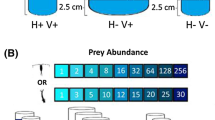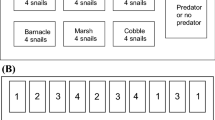Abstract
Many species are able to modify aspects of their behaviour and morphology in the presence of predators. The aim of this study was to investigate the relationship between the expression of morphological and behavioural defences according to the framework proposed by DeWitt et al (1999). Experiments were carried out using hypotrich ciliates of the genus Euplotes as prey and turbellarians of the genus Stenostomum as predators. The smaller species Euplotes octocarinatus showed a greater proportional increase in width, a reduction in foraging movement rates and an increase in maximum movement rates following exposure to predator cues. The larger Euplotes aediculatus induced lesser changes in width, similar reductions in movement during foraging and no change in maximum speed following predator exposure. These results provide evidence of a cospecialised relationship between morphological and behavioural defences. Despite substantial differences in the absence of predators, movement rates and lateral body width were similar in both species following predator exposure. The observed changes may be considered adaptive, gape limited flatworm predators are unable to ingest large Euplotes and a reduction in movement rates during foraging reduces predator encounter rates, while an increase in maximal movement rates increases chances of predator evasion.


Similar content being viewed by others
References
Altwegg, R., K. B. Marchinko, S. L. Duquette & B. R. Anholt, 2004. Dynamics of an inducible defence in the protist Euplotes. Archiv Fur Hydrobiologie 160: 431–446.
Altwegg, R., M. Eng, S. Caspersen & B. R. Anholt, 2006. Functional response and prey defence level in an experimental predator-prey system. Evolutionary Ecology Research 8: 115–128.
Anholt, B. R. & E. E. Werner, 1995. Interaction between food availability and predation mortality mediated by adaptive-behavior. Ecology 76: 2230–2234.
Anholt, B. R. & E. E. Werner, 1998. Predictable changes in predation mortality as a consequence of changes in food availability and predation risk. Evolutionary Ecology 12: 729–738.
Anholt, B. R., E. Werner & D. K. Skelly, 2000. Effect of food and predators on the activity of four larval ranid frogs. Ecology 81: 3509–3521.
Blaustein, A. R., D. P. Chivers, L. B. Kats & J. M. Kiesecker, 2000. Effects of ultraviolet radiation on locomotion and orientation in Roughskin Newts (Taricha granulosa). Ethology 106: 227–234.
Boersma, M., P. Spaak & L. De Meester, 1998. Predator-mediated plasticity in morphology, life history, and behavior of Daphnia: The uncoupling of responses. American Naturalist 152: 237–248.
Brodie, E. D. I., 1992. Correlational selection for color pattern and antipredator behavior in the garter snake Thamnophis ordinoides. Evolution 46: 1284–1298.
Dayton, G. H., D. Saenz, K. A. Baum, R. B. Langerhans & T. J. DeWitt, 2005. Body shape, burst speed and escape behavior of larval anurans. Oikos 111: 582–591.
DeWitt, T. J., A. Sih & J. A. Hucko, 1999. Trait compensation and cospecialisation in a freshwater snail: Size shape and antipredator behaviour. Animal Behaviour 58: 397–407.
Dixon, S. M. & R. L. Baker, 1988. Effects of size on predation risk, behavioral-response to fish, and cost of reduced feeding in larval Ischnura verticalis (Coenagrionidae, Odonata). Oecologia 76: 200–205.
Duquette, S. L., R. Altwegg & B. R. Anholt, 2005. Factors affecting the expression of inducible defences in Euplotes: Genotype, predator density and experience. Functional Ecology 19: 648–655.
Humphries, D. A. & P. M. Driver, 1970. Protean defence by prey animals. Oecologia 5: 285–302.
Kuhlmann, H. W., 1994. Escape response of Euplotes-Octocarinatus to turbellarian predators. Archiv Fur Protistenkunde 144: 163–171.
Kuhlmann, H. W. & K. Heckmann, 1994. Predation risk of typical ovoid and winged morphs of Euplotes (Protozoa, Ciliophora). Hydrobiologia 284: 219–227.
Kusch, J., 1993a. Behavioral and morphological-changes in ciliates induced by the predator Amoeba proteus. Oecologia 96: 354–359.
Kusch, J., 1993b. Induction of defensive morphological-changes in ciliates. Oecologia 94: 571–575.
Lawler, S. P., 1989. Behavioral-responses to predators and predation risk in 4 species of larval anurans. Animal Behaviour 38: 1039–1047.
Lima, S. L., 1998. Stress and decision making under the risk of predation: Recent developments from behavioral, reproductive, and ecological perspectives. Stress and Behavior: 215–290.
McCollum, S. A. & J. Van Buskirk, 1996. Costs and benefits of a predator-induced polyphenism in the gray treefrog Hyla chrysoscelis. Evolution 50: 583–593.
McPeek, M. A., A. K. Schrot & J. M. Brown, 1996. Adaptation to predators in a new community: Swimming performance and predator avoidance in damselflies. Ecology 77: 617–629.
Mikolajewski, D. J. & F. Johansson, 2004. Morphological and behavioral defenses in dragonfly larvae: Trait compensation and cospecialization. Behavioral Ecology 15: 614–620.
Morin, P., 1999. Productivity, intraguild predation, and population dynamics in experimental food webs. Ecology 80: 752–760.
Pardi, L. & F. Papi, 1967. Kinetic and tactic responses. In Waterman, T. H. (ed.), The Physiology of Crustacea. Academic Press, New York and London: 365–399.
Relyea, R. A., 2001. Morphological and behavioral plasticity of larval anurans in response to different predators. Ecology 82: 523–540.
Rundle, S. D. & C. Bronmark, 2001. Inter- and intraspecific trait compensation of defence mechanisms in freshwater snails. Proceedings of the Royal Society of London Series B-Biological Sciences 268: 1463–1468.
Schaffner, A. K. & B. R. Anholt, 1998. Influence of predator presence and prey density on behavior and growth of damselfly larvae (Ischnura elegans) (Odonata: Zygoptera). Journal of Insect Behavior 11: 793–809.
Tillmann, U. & W. Lampert, 1984. Competitive ability of differently sized daphnia species—an experimental test. Journal of Freshwater Ecology 2: 311–323.
Tollrian, R. & C. D. Harvell, 1999. The Ecology and Evolution of Inducible Defenses. Princeton University Press, Princeton.
Touchon, J. C. & K. M. Warkentin, 2008. Fish and dragonfly nymph predators induce opposite shifts in color and morphology of tadpoles. Oikos 117: 634–640.
Van Buskirk, J. & S. A. McCollum, 2000. Functional mechanisms of an inducible defence in tadpoles: Morphology and behaviour influence mortality risk from predation. Journal of Evolutionary Biology 13: 336–347.
Wiackowski, K. & A. Staronska, 1999. The effect of predator and prey density on the induced defence of a ciliate. Functional Ecology 13: 59–65.
Acknowledgements
We wish to thank John Taylor for the use of microscopic equipment (funded by CFI) and Maarten Voordouw for his insightful comments on earlier versions of this manuscript. This work was funded by an NSERC Discovery grant awarded to Bradley R. Anholt and the Canada Research Chairs programme.
Author information
Authors and Affiliations
Corresponding author
Additional information
Handling editor: S. I. Dodson
Rights and permissions
About this article
Cite this article
Hammill, E., Kratina, P. & Anholt, B.R. Non-lethal presence of predators modifies morphology and movement rates in Euplotes . Hydrobiologia 621, 183–189 (2009). https://doi.org/10.1007/s10750-008-9644-1
Received:
Revised:
Accepted:
Published:
Issue Date:
DOI: https://doi.org/10.1007/s10750-008-9644-1




